Solid Particle Erosion Studies of Varying Tow-Scale Carbon Fibre-Reinforced Polymer Composites
Abstract
1. Introduction
2. Experimental Work
2.1. Materials and Composite Preparation
2.2. Erosion Experiment
2.3. Experimental Plan
3. Results and Discussion
3.1. Physical and Mechanical Properties
3.2. Effect of Parameters on Erosion Rate
3.3. Effect of Parameters on Surface Roughness
3.4. Surface Topography Analysis
4. Conclusions
- The strength and the hardness of the composite increased to the maximum value for the increment of the tow scale from 5k to 10k, and then it tended to decrease.
- When the effect of erodent velocity was observed, it was higher, and the erosion rate and the surface roughness of the composite were also higher.
- The minimum erosion rate and a good surface finish were noticed at a higher impingement angle of 90 degrees, whereas the minimum impact angle of 30 degrees led to higher erosion rates and a poor surface finish.
- The erosion rate and the surface roughness of the composite were maximum for the 10k tow size fibre-reinforced polymer composite, whereas the 15k tow size fibre-reinforced polymer composite possessed an improved surface finish with a comparatively lower erosion rate.
- The eroded particles supplied at lower speeds did not penetrate the composite surface. The lower the collision force, the harder the traces on the surface, yet there was no sign of fibre breaking or pull-out.
- The passage of erodent particles on the composite caused surface waviness (flow trace), which prevented the surface from degrading.
- In the future, the same study can be extended to determine the erosion performance for varying percentages of fibre reinforcements and other fibre-reinforced polymer composites.
Author Contributions
Funding
Institutional Review Board Statement
Informed Consent Statement
Data Availability Statement
Conflicts of Interest
References
- Ravichandran, M.; Naveen Sait, A.; Anandakrishnan, V. Synthesis and forming characteristics of Al-TiO2 powder metallurgy composites during cold upsetting under plane stress state conditions. J. Sandw. Struct. Mater. 2015, 17, 278–294. [Google Scholar] [CrossRef]
- Ku, H.; Wang, H.; Pattarachaiyakoop, N.; Trada, M. A review on the tensile properties of natural fiber reinforced polymer composites. Compos. Part B 2011, 42, 856–873. [Google Scholar] [CrossRef]
- Wang, K. In-situ 3D fracture propagation of short carbon fiber reinforced polymer composites. Compos. Sci. Technol. 2019, 182, 107788. [Google Scholar] [CrossRef]
- Mouhmid, B. An experimental analysis of fracture mechanisms of short glass fibre reinforced polyamide 6,6 (SGFR-PA66). Compos. Sci. Technol. 2009, 15–16, 2521–2526. [Google Scholar] [CrossRef]
- Midgett, D.E. The pressure-induced deformation response of the human lamina cribrosa: Analysis of regional variations. Acta Biomater. 2017, 53, 123–139. [Google Scholar] [CrossRef]
- Weber, B. Automated tracing of microtubules in electron tomograms of plastic embedded samples of Caenorhabditis elegans embryos. J. Struct. Biol. 2012, 178, 129–138. [Google Scholar] [CrossRef]
- Garcea, S.C. X-ray computed tomography of polymer composites. Compos. Sci. Technol. 2018, 156, 305–319. [Google Scholar] [CrossRef]
- Huang, W. Transverse compaction of 2D glass woven fabrics based on material twins—Part II: Tow and fabric deformations. Compos. Struct. 2020, 237, 111963. [Google Scholar] [CrossRef]
- Mohseni-Mofidi, S.; Drescher, E.; Kruggel-Emden, H.; Teschner, M.; Bierwisch, C. Particle-Based Numerical Simulation Study of Solid Particle Erosion of Ductile Materials Leading to an Erosion Model, Including the Particle Shape Effect. Materials 2015, 15, 286. [Google Scholar] [CrossRef] [PubMed]
- Nisa, Z.U.; Chuan, L.K.; Guan, B.H.; Ayub, S.; Ahmad, F. Anti-Wear and Anti-Erosive Properties of Polymers and Their Hybrid Composites: A Critical Review of Findings and Needs. Nanomaterials 2022, 12, 2194. [Google Scholar] [CrossRef] [PubMed]
- Hussein, A.B.; Hashim, F.A.; Kadhim, T.R. Comparison study of erosion wear and hardness of GF/EP with nano and micro SiO2 hydride composites. Eng. Technol. J. 2015, 33, 1761–1774. [Google Scholar]
- Finie, M.; Adler, W.F. The mechanics of liquid impact. In Treatise on Materials Science and Technology 16; Preece, C.M., Ed.; Academic Press: Cambridge, MA, USA, 1979. [Google Scholar]
- Babu, B.G.; Karthikeyan, P.N.; Siva, K.; Sabarinathan, C. Study of erosion characteristics of MWCNT’s-alumina hybrid epoxy nanocomposites under the influence of solid particles. Dig. J. Nanomater. Biostructures 2016, 11, 1367–1373. [Google Scholar]
- Das, G.; Biswas, S. Erosion wear behavior of coir fiber reinforced epoxy composites filled with Al2O3 filler. J. Ind. Text. 2017, 47, 472–488. [Google Scholar] [CrossRef]
- Jena, H.; Satapathy, A. Fabrication, mechanical characterization and wear response of hybrid composites filled with red mud: An alumina plant waste. Proc. Int. Conf. Adv. Mech. Eng. 2011, 2, 67–71. [Google Scholar]
- Patel, B.; Acharya, S.; Mishra, D. Effect of stacking sequence on the erosive wear behavior of jute and juteglass fabric reinforced epoxy composite. Int. J. Eng. Sci. Technol. 2011, 3, 213–219. [Google Scholar] [CrossRef]
- Miyazaki, N. Solid particle erosion of composite materials: A critical review. J. Compos. Mater. 2016, 50, 3175–3217. [Google Scholar] [CrossRef]
- Vigneshwaran, S.; Uthayakumar, M.; Arumugaprabu, V. A review on erosion studies of fiber-reinforced polymer composites. J. Reinf. Plast. Compos. 2017, 3, 1019–1027. [Google Scholar] [CrossRef]
- Debnath, U.K.; Chowdhury, M.A.; Nuruzzaman, D.M. Erosive wear characteristics of multi-fiber reinforced polyester under different operating conditions. In Proceedings of the Joint Conference of iMEC2015 (2nd International Manufacturing Conference) & APCOMS2015 (3rd Asia Pacific Conference on Manufacturing System), Kuala Lumpur, Malaysia, 5–7 November 2015; Universiti Malaysia Pahang; Volume 114, p. 012113.
- Bagci, M.; Imrek, H.; Aktas, A. Solid particle erosion behaviour of glass mat-based polyester laminate composite materials. J. Thermoplast. Compos. Mater. 2011, 26, 777–794. [Google Scholar] [CrossRef]
- Suihkonen, R.; Perolainen, J.; Lindgren, M. Erosion wear of glass fibre reinforced vinyl ester. Tribol. Finn. J. Tribol. 2015, 33, 11–19. [Google Scholar]
- Zhang, H.; Zhang, Z.; Friedrich, K. Effect of fiber length on the wear resistance of short carbon fiber reinforced epoxy composites. Compos. Sci. Technol. 2007, 67, 222–230. [Google Scholar] [CrossRef]
- Rao, V.A.; Satapathy, A.; Mishra, S.C. Polymer composites reinforced with short fibers obtained from poultry feathers. In Proceedings of the International and INCCOM-6 Conference Future Trends in Composite Materials and Processing, Kanpur, India, 12–14 December 2007; Indian Institute of Technology; pp. 530–534.
- Rahul Tarodiya; Avi Levy. Erosion of polymers and polymer composites surfaces by particles. Adv. Powder Technol. 2021, 32, 3149–3159. [Google Scholar] [CrossRef]
- Arani, N.H.; Eghbal, M.; Papini, M. Modeling the solid particle erosion of rubber particulate-reinforced epoxy. Tribol. Int. 2021, 153, 106656. [Google Scholar]
- Patnaik, A.; Satapathy, A.; Mahapatra, S.S.; Dash, R.R. Parametric optimization erosion wear of polyester-GF-alumina hybrid composites using the Taguchi method. J. Reinf. Plast. Compos. 2008, 27, 1039–1058. [Google Scholar] [CrossRef]
- Kurniawan, R.; Kumaran, S.T.; Prabu, V.A.; Zhen, Y.; Park, K.M.; Kwak, Y.I.; Islam, M.M.; Ko, T.J. Measurement of burr removal rate and analysis of machining parameters in ultrasonic assisted dry EDM (US-EDM) for deburring drilled holes in CFRP composite. Measurement 2017, 110, 98–115. [Google Scholar] [CrossRef]
- Patnaik, A.; Satapathy, A.; Mahapatra, S.S.; Dash, R.R. Implementation of Taguchi design for erosion of fiber-reinforced polyester composite systems with SiC filler. J. Reinf. Plast. Compos. 2008, 27, 1093–1111. [Google Scholar] [CrossRef]
- Tewari, U.S.; Harsha, A.P.; Häger, A.M.; Friedrich, K. Solid particle erosion of unidirectional carbon fibre reinforced polyetheretherketone composites. Wear 2002, 252, 992–1000. [Google Scholar] [CrossRef]
- Debnath, U.K.; Chowdhury, M.A.; Kowser, M.A.; Mia, M.S. Study of erosion characterization of carbon fiber reinforced composite material. AIP Conf. Proc. 2017, 1851, 020098. [Google Scholar]
- Tejyan, S. Effect of erosive parameters on solid particle erosion of cotton fiber–based nonwoven mat/wooden dust reinforced hybrid polymer composites. J. Ind. Text. 2022, 51, 2514S–2532S. [Google Scholar] [CrossRef]
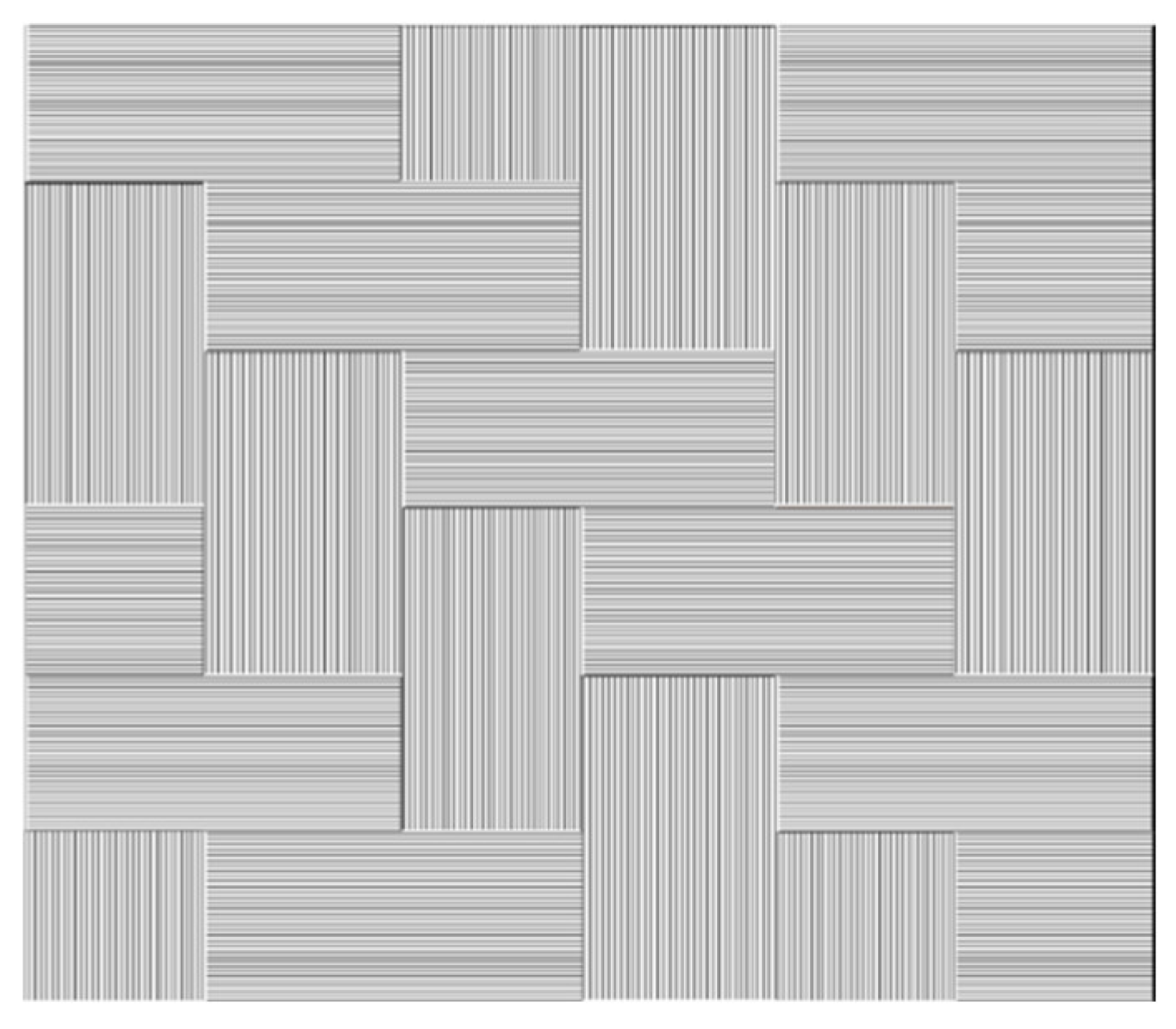
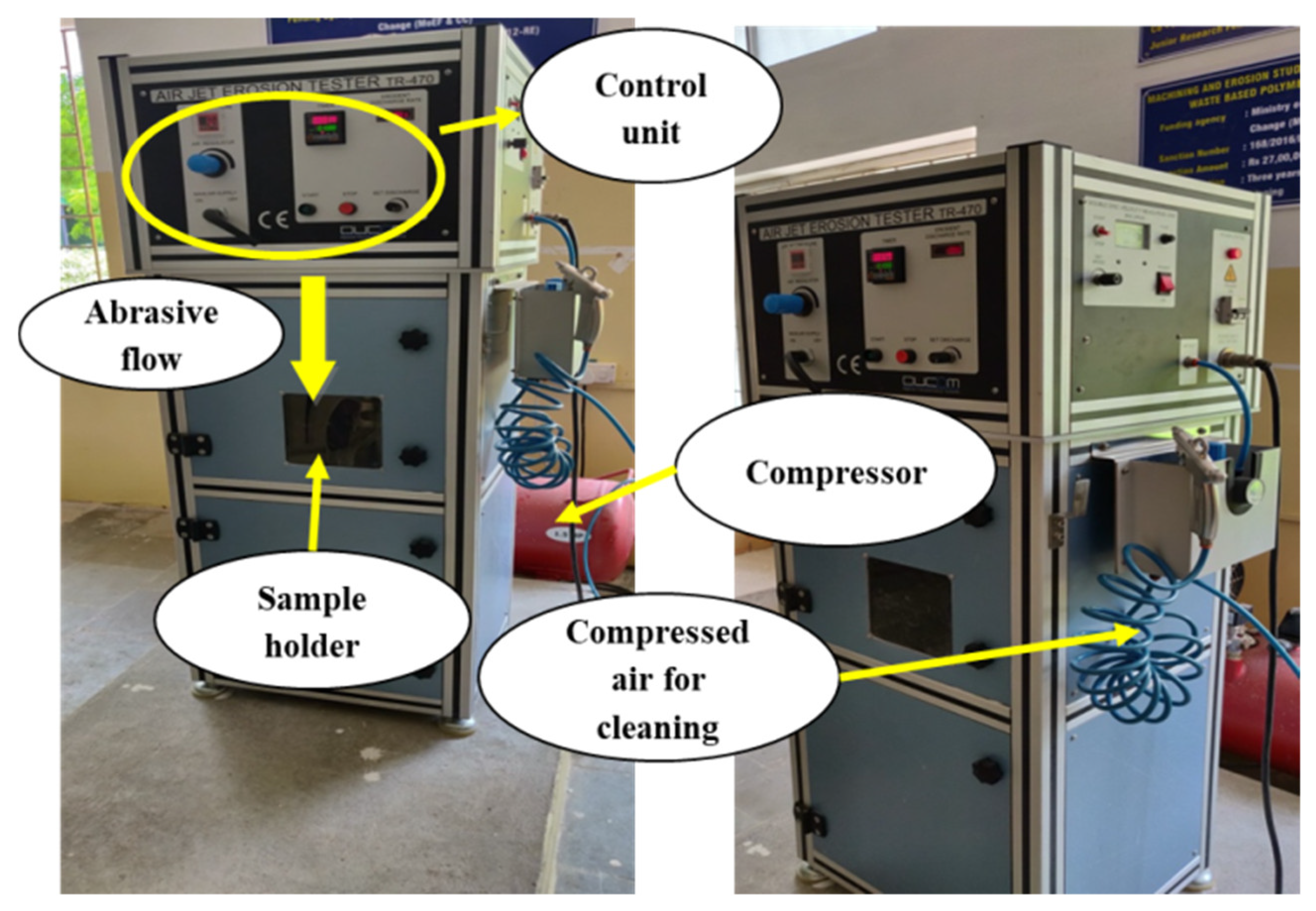
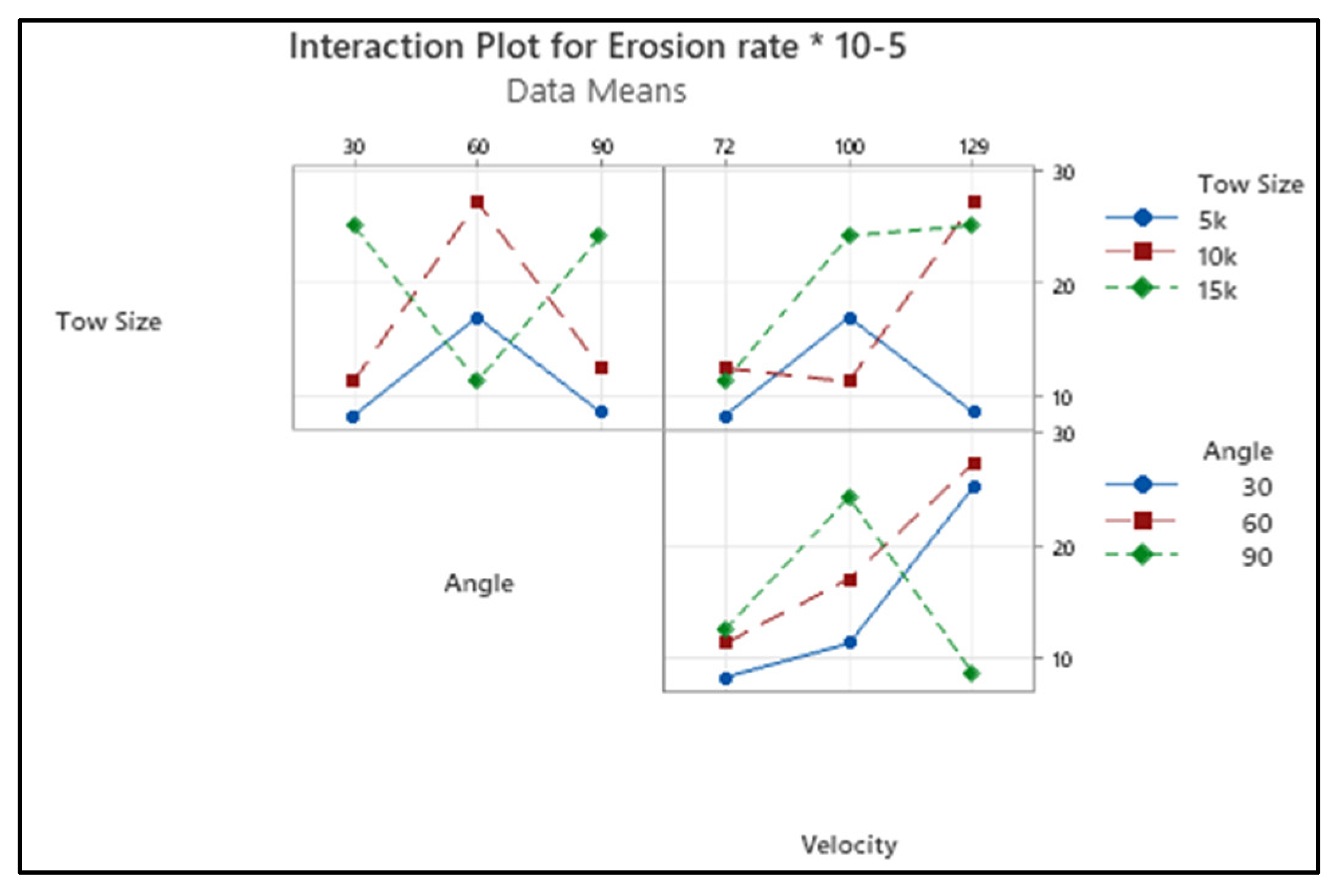
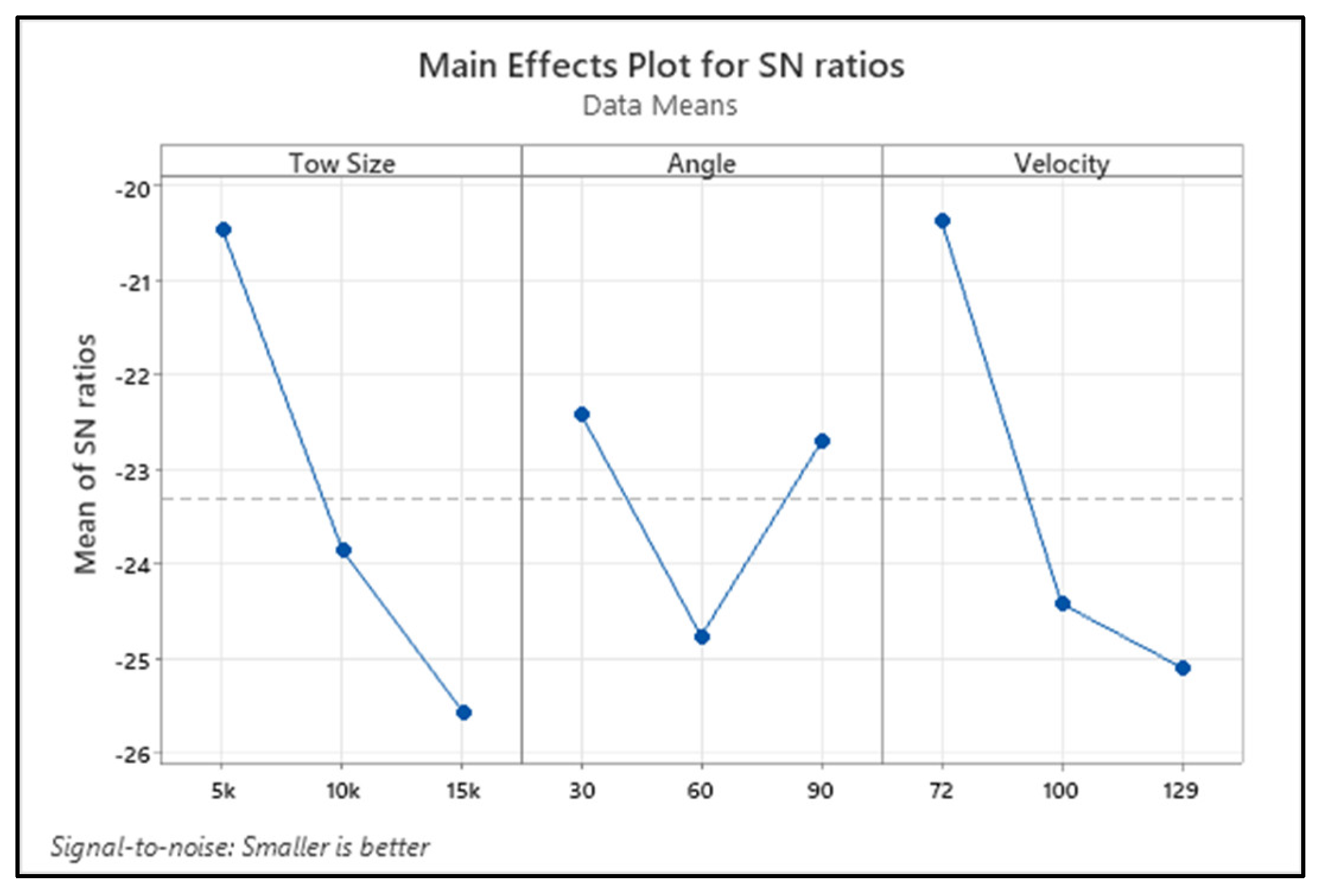
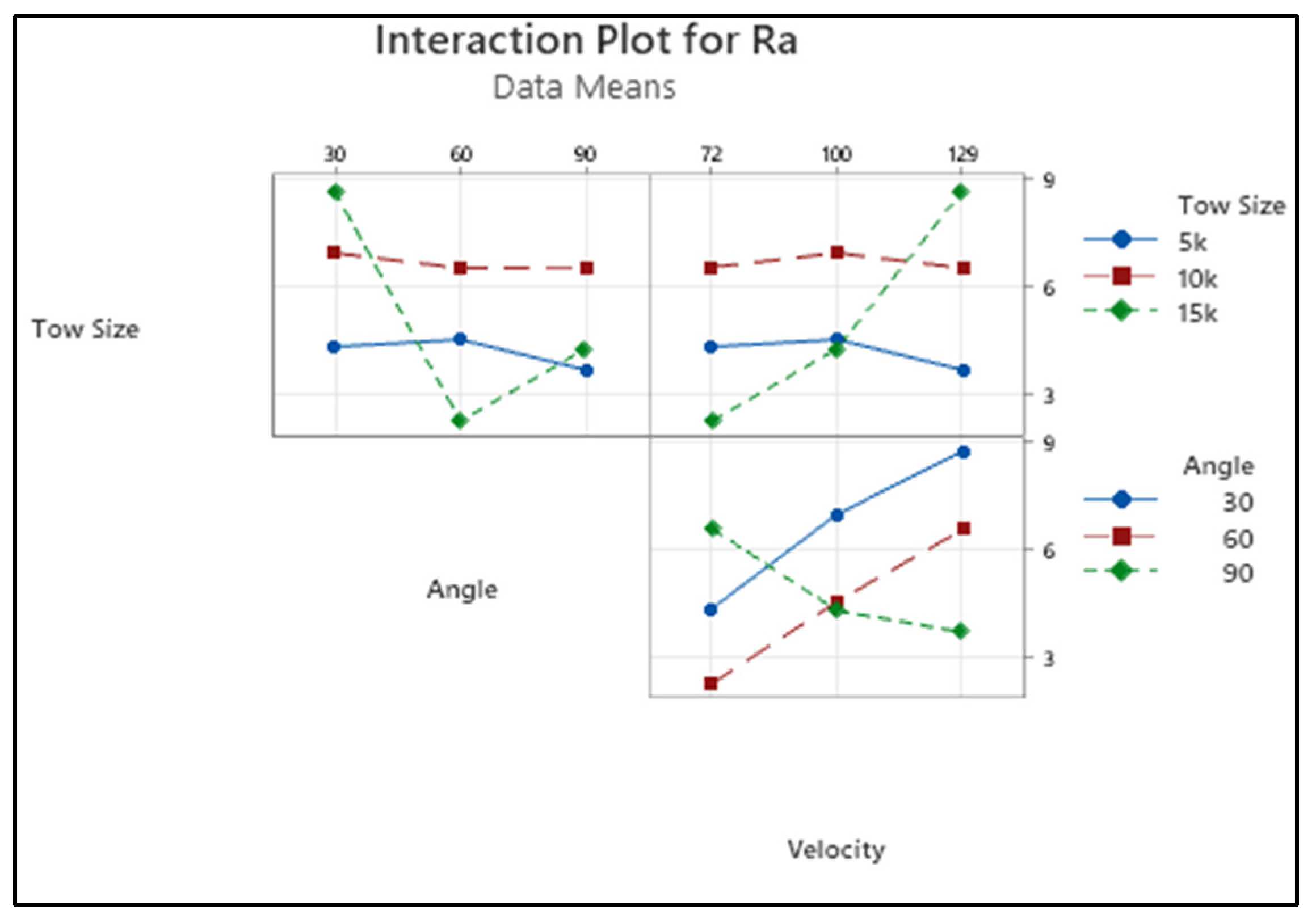
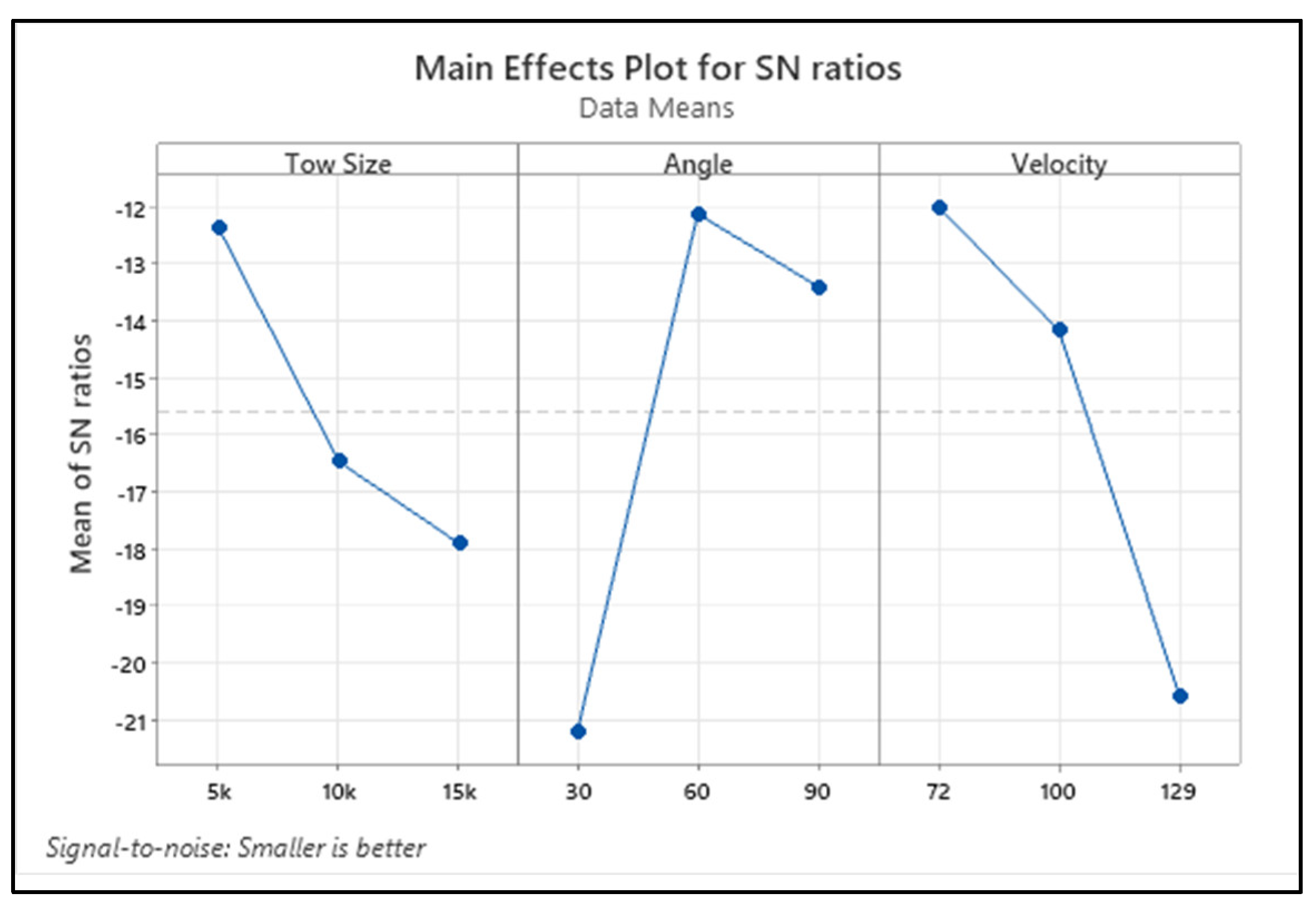




| Filament Count | Yield (g/1000m) | Tensile Strength (MPa) | Tensile Modulus (GPa) | Density (g/cm3) | Strain (%) |
|---|---|---|---|---|---|
| 3K | 200 | 3800 | 240 | 1.78 | 1.6 |
| 6K | 400 | 3800 | 240 | 1.78 | 1.6 |
| SNo. | Parameters | Unit | Level/Range |
|---|---|---|---|
| 1 | Impact angle | degree | 30, 60, 90 |
| 2 | Erodent velocity | m/s | 72, 100, 129 |
| 3 | Tow size | Counts | 5K, 10K, and 15K |
| 4 | Standoff distance | mm | 10 |
| 5 | Discharge rate | g/min | 3.3 |
| SNo. | Specimen | Tensile Strength (N/mm2) | Flexural Strength (N/mm2) | Impact Strength (J/m) | Hardness (HRN) | Density (g/mm3) |
|---|---|---|---|---|---|---|
| 1 | 5K | 441.94 | 724.46 | 34 | 112 | 1.515 |
| 2 | 10K | 450.11 | 794.23 | 36 | 116 | 1.593 |
| 3 | 15K | 379.48 | 751.80 | 36 | 112 | 1.489 |
| SNo. | Tow | Angle (Degree) | Velocity (m/s) | Erosion Rate × 10−5 (g/g) | Roughness, Ra (μm) |
|---|---|---|---|---|---|
| 1 | 5K | 30 | 72 | 8.1818 | 4.314 |
| 2 | 5K | 60 | 100 | 16.9697 | 4.519 |
| 3 | 5K | 90 | 129 | 8.4848 | 3.669 |
| 4 | 10K | 30 | 72 | 11.2121 | 6.938 |
| 5 | 10K | 60 | 100 | 27.2727 | 6.514 |
| 6 | 10K | 90 | 129 | 12.4242 | 6.540 |
| 7 | 15K | 30 | 72 | 25.1515 | 8.685 |
| 8 | 15K | 60 | 100 | 11.2121 | 2.237 |
| 9 | 15K | 90 | 129 | 24.2424 | 4.262 |
| Level | Tow Size | Angle | Velocity |
|---|---|---|---|
| 1 | −20.47 | −22.42 | −20.38 |
| 2 | −23.86 | −24.77 | −24.43 |
| 3 | −25.57 | −22.72 | −25.10 |
| Delta | 5.09 | 2.35 | 4.72 |
| Rank | 1 | 3 | 2 |
| Factors | Adj SS | DOF | Adj MS | % of Contribution | F-Value |
|---|---|---|---|---|---|
| Tow | 40.4262 | 2 | 20.2131 | 45.23343 | 29,111.66 |
| Angle | 9.815 | 2 | 4.9075 | 10.98214 | 7067.965 |
| Velocity | 39.1298 | 2 | 19.5649 | 43.78287 | 28,178.1 |
| Error | 0.001389 | 2 | 0.000694 | 0.001554 | |
| Total | 89.37239 | 8 | 44.68619 |
| Level | Tow Size | Angle | Velocity |
|---|---|---|---|
| 1 | −12.36 | −21.22 | −12.00 |
| 2 | −16.47 | −12.12 | −14.17 |
| 3 | −17.91 | −13.40 | −20.57 |
| Delta | 5.55 | 9.10 | 8.57 |
| Rank | 3 | 1 | 2 |
| Factors | Adj SS | DOF | Adj MS | % of Contribution | F-Value |
|---|---|---|---|---|---|
| Tow | 49.7682 | 2 | 24.8841 | 15.82534 | 35,839.01 |
| Angle | 145.6008 | 2 | 72.8004 | 46.29829 | 104,849.9 |
| Velocity | 119.1138 | 2 | 59.5569 | 37.87593 | 85,776.07 |
| Error | 0.001389 | 2 | 0.000694 | 0.000442 | |
| Total | 314.4842 | 8 | 157.2421 |
Publisher’s Note: MDPI stays neutral with regard to jurisdictional claims in published maps and institutional affiliations. |
© 2022 by the authors. Licensee MDPI, Basel, Switzerland. This article is an open access article distributed under the terms and conditions of the Creative Commons Attribution (CC BY) license (https://creativecommons.org/licenses/by/4.0/).
Share and Cite
Shanmugam, S.K.; Sundaresan, T.K.; Varol, T.; Kurniawan, R. Solid Particle Erosion Studies of Varying Tow-Scale Carbon Fibre-Reinforced Polymer Composites. Materials 2022, 15, 7534. https://doi.org/10.3390/ma15217534
Shanmugam SK, Sundaresan TK, Varol T, Kurniawan R. Solid Particle Erosion Studies of Varying Tow-Scale Carbon Fibre-Reinforced Polymer Composites. Materials. 2022; 15(21):7534. https://doi.org/10.3390/ma15217534
Chicago/Turabian StyleShanmugam, Suresh Kumar, Thirumalai Kumaran Sundaresan, Temel Varol, and Rendi Kurniawan. 2022. "Solid Particle Erosion Studies of Varying Tow-Scale Carbon Fibre-Reinforced Polymer Composites" Materials 15, no. 21: 7534. https://doi.org/10.3390/ma15217534
APA StyleShanmugam, S. K., Sundaresan, T. K., Varol, T., & Kurniawan, R. (2022). Solid Particle Erosion Studies of Varying Tow-Scale Carbon Fibre-Reinforced Polymer Composites. Materials, 15(21), 7534. https://doi.org/10.3390/ma15217534









